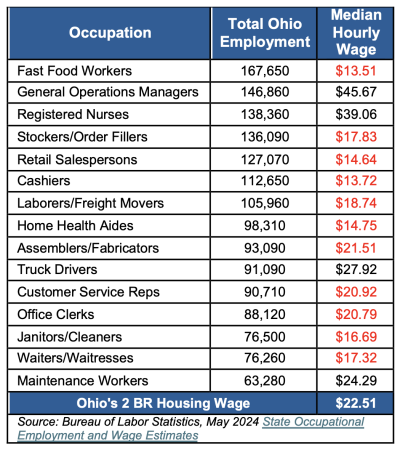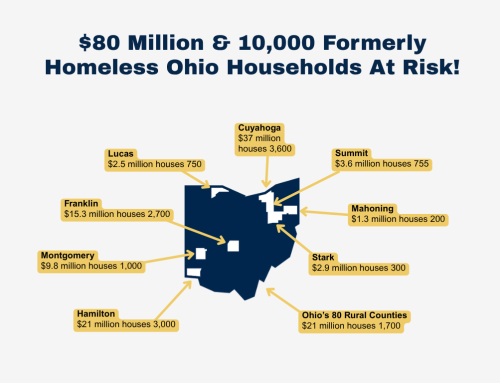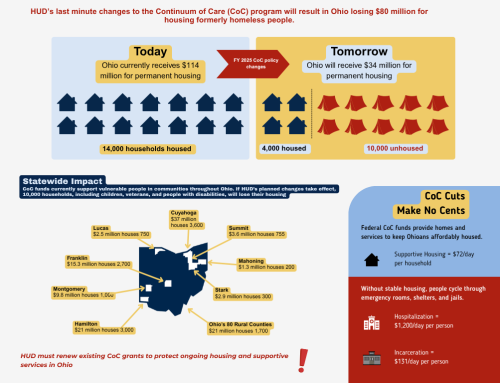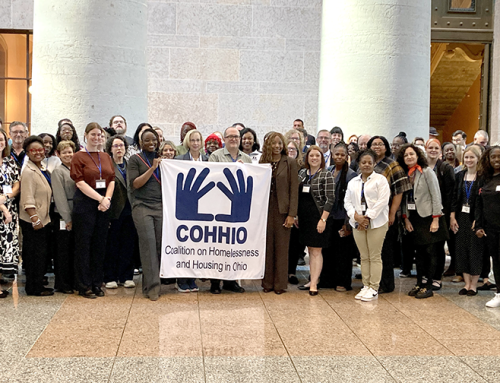FOR IMMEDIATE RELEASE: July 17, 2025
CONTACT: Marcus Roth, 614-280-1984 x.111
Gap Between Ohio Rents and Tenants’ Income Doubled Since 2020
Full-time workers need to earn at least $22.51/hour just to afford a modest two-bedroom apartment in Ohio, according to a report jointly released Thursday by the National Low Income Housing Coalition and the Coalition on Homelessness and Housing in Ohio.
The 2025 Out of Reach report shows that the disparity between renters’ income and the cost of rent in Ohio has more than doubled since the beginning of the pandemic in 2020. The average Ohio renter now earns $18.62/hour, or $3.89/hour less than the 2-bedroom Housing Wage. In 2020, the difference was $1.57/hour, a gap that has increased 148% in five years.
The Housing Wage is an estimate of the hourly wage full-time workers must earn to afford a rental home at HUD’s Fair Market Rent without spending more than 30% of their incomes.
The report also found that only 4 out of the 15 most common jobs in the Buckeye State pay more than the 2025 Housing Wage. That means nearly 1.2 million jobs – 21% of all the jobs in Ohio – don’t pay enough to afford a basic two-bedroom apartment.
 In some areas, the Housing Wage is considerably higher than the statewide average. For example, renter households living in the Columbus area need to earn at least $27.79/hour to afford a two-bedroom apartment. The Housing Wage in Cincinnati is $24.75/hour and in Cleveland it’s $23.23/hour.
In some areas, the Housing Wage is considerably higher than the statewide average. For example, renter households living in the Columbus area need to earn at least $27.79/hour to afford a two-bedroom apartment. The Housing Wage in Cincinnati is $24.75/hour and in Cleveland it’s $23.23/hour.
COHHIO Executive Director Amy Riegel said that workers’ wages have increased in recent years, but rents have risen much faster.
“The cost of rent is squeezing working Ohioans like never before. Rent now consumes so much of the income that people need just to survive,” she said. “That’s why we’re seeing more and more seniors wind up in the homeless system.”
According to the annual report, Ohio’s Housing Wage has increased 40.7% since 2020, far outpacing most renters’ income. By comparison, the median home health aide wage went from $11.41/hour to $14.75/hour, but the 2-bedroom Housing Wage increased from $15.99/hour to $22.51/hour during the past five years.
“The state has taken steps to improve home health care aides’ pay to support Ohio’s growing senior population. But home health aides still can’t afford to live near many of their clients, and they can’t afford the food, transportation, healthcare, and childcare they need to keep working,” Riegel said. “Every year the housing market keeps pushing people closer and closer to the breaking point.”
Riegel praised legislators for continuing the new Ohio Low Income Housing Tax Credit program and preserving the Ohio Housing Trust Fund in the new biennial budget passed last month. However, she said state policymakers will need to consider investing more to ensure the most vulnerable Ohioans don’t fall through the cracks.
Meanwhile, federal housing assistance is at risk as the Trump Administration has proposed cutting 44% of HUD’s overall funding and eliminating rental assistance programs.
“Housing is more than just a shelter, it is foundational to well-being and dignity,” said NLIHC President and CEO Renee Willis. “This year’s Out of Reach report shows that, despite economic gains for some, low-income renters continue to face impossible choices between paying rent and meeting basic needs. Cutting federal housing investments would only deepen the housing crisis. Congress must protect and expand housing programs that ensure stability, opportunity, and a pathway out of poverty for millions of renters.”
-30-








